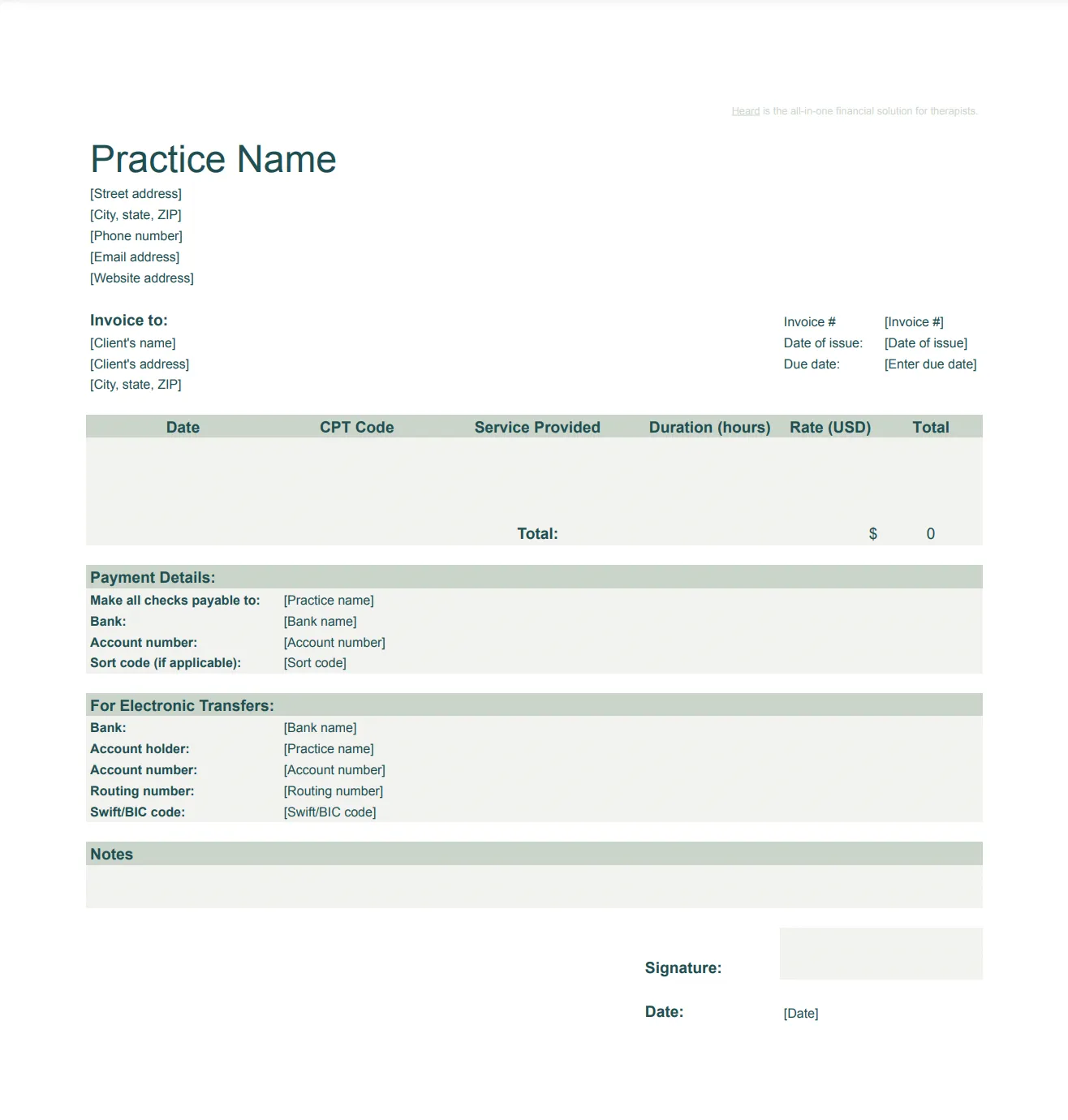When you run your own therapy practice, good invoicing helps you get paid faster.
Thorough, carefully filled-out invoices make it easier for clients to understand what they owe and how they can pay you. Not only that, but clients filing health insurance claims in order to be reimbursed for the cost of therapy rely on detailed invoices to do so.
The easiest way to invoice clients is with a template. Keep reading for a free invoice template for therapy practices, plus instructions on how to fill it out.
{{resource}}
How to send a HIPAA-compliant invoice
In order to be HIPAA-compliant, invoices you send patients electronically must be protected from third parties.
On the surface, emails may seem like a simple, direct way to communicate with your clients. On the technical side, it’s much more complex.
The data contained in an email may bounce between a number of different servers before reaching its final destination. Each time it travels from one server to another, it’s vulnerable to theft.
Hackers may use your patients’ data for the purpose of identity theft, blackmail, or fraud. Not only does that hurt your client, but it could result in steep fines for your practice.
There’s not much you can do to stop emailed invoices from being intersected and stolen. But there are steps you can take to make sure the data is unreadable and can’t be used to violate your clients’ privacy.
The most direct method is encryption. When you pay for a HIPAA-compliant email service like Gmail for business, you can encrypt emails to clients, keeping their private data safe.
Any electronic health records (EHR) tool that allows you to bill clients should also be HIPAA-compliant.
Other invoicing apps or accounting software may or may not be HIPAA-compliant or provide encryption. Make sure you’re using a 100% HIPAA-compliant method before sending any client data over the internet.
For more information, check out our HIPAA Compliance Checklist for Therapists.
Why you need an invoice template for your therapy practice
If you’ll be invoicing your clients by email, it’s absolutely essential to choose a template that works for your practice.
While your exact needs may differ somewhat, here’s what any template you use should include:
- Your practice’s name, your address, and other contact info
- Your client’s name and address
- The invoice number
- A section where you list services being charged for (line items)
- A section showing the costs and total cost of the items you’re charging for
- Details on how clients can pay you by check, eTransfer, or ACH
- A section for extra notes
- The date and your signature
Heard’s free invoice template for therapy practices below includes all of these sections.
Heard’s free invoice template for therapists
Here’s a quick preview of Heard’s free invoice template for therapists:

Here’s how to access the template and make a copy for yourself:
- Log in to your Google account.
- Sign up to receive the template in the Heard Resource Hub: Invoice Template for Therapists. The email will be sent directly to your inbox.
- Check your email, then access the template by clicking the “Download template” button.
- In Google Sheets, go to File > Make a copy.
- Google Sheets will prompt you to save a copy of the file to your own Google Drive folder
- Select a folder in Google Drive*, then click “Make a copy.”
- A new tab will open showing your own, personal copy of the template.
* If you’re not super familiar with Google Drive and you’re not sure where to save the template, don’t worry. When the dialog opens prompting you to choose a folder, click “All locations” and select My Drive.
You can now close the tab with the original Heard Invoice Template for Therapists, and begin using your own copy of the template to create invoices.
How to create an invoice in Google Sheets with your copy of the template
The easiest way to create new invoices using the template is to make copies of it, and fill out each copy as a separate invoice.
Heads up: Before saving any client data in the cloud, make sure to read up on Google and HIPAA compliance.
But before making any copies, fill out your practice name, address, signature, and contact info. It will save you having to enter the same information each time you create a new invoice.
Then, go to File > Make a copy to start creating copies.
How to add your signature
If you have a copy of your signature saved on your computer, you can add it to the Google Sheets template so it’s included on every invoice you send.
First, select the shaded cell next to “Signature:” (cell E38).
Then, in Google Sheets, go to Insert > Image > Insert an image over the cells.
Now you can resize your signature and drag it into the right position on the template.
{{resource}}
How to email your client an invoice created with the template
Before emailing your client a copy of an invoice, convert it to a PDF.
The PDF format is easier to share if your client doesn’t have Excel or Google Sheets.
To export a PDF version, go to File > Download > PDF (.pdf)
How to turn the Google Sheets template into an Excel spreadsheet
You can convert your Google Sheets invoice template into an .xlsx file readable by Microsoft Excel.
This is a good idea if you already have Excel installed, know how to use it, and want to fill out and store all your invoices natively on your own computer rather than in the cloud.
To download a copy of the template for Excel, go to File > Download > Microsoft Excel (.xlsx)
Example therapy invoice
To get a better idea of how the Heard Invoice Template for Therapists works, here’s an example of it in action:

The template is being used by an imaginary therapy practice in Boise, Idaho. The client being invoiced is imaginary, too.
At the top, we see names and contact info for the practice and the client.
To the right of that, there’s the invoice number and the date of issue, as well as the due date.
You can number your invoices any way that works for you. The numbers are for your use internally, so you can keep track of the invoices you’ve sent; and for communications with clients, bookkeepers, and accountants, so it’s easy to refer to specific invoices.
Next, the line items. These are the meat of the invoice. There are spaces for:
- The date the service was rendered
- The CPT code (important if your client is being reimbursed by their insurance provider)
- The type of service provided
- The duration of the service
- Your hourly rate
- The total cost of each line item
- The total cost, at the bottom, of all line items
Note that the template will automatically multiply the duration in each line item in hours by your hourly rate in dollars to arrive at the total.
Below, there’s space to fill in account and routing numbers so your client can pay you electronically or by check.
Then there’s a space for notes, in case you need to provide any extra contextual information about the invoice.
Finally, there’s the issuer’s signature and the date.
Once you’ve saved a copy of the invoice template for yourself, it’s 100% editable. You’re free to add or remove sections as you see fit. The template is just a starting point, and the only limit to what you can do is how much time and energy you’re willing to invest.
—
Invoicing clients electronically? Learn more about HIPAA-compliant payment methods for therapists.
This post is to be used for informational purposes only and does not constitute legal, business, or tax advice. Each person should consult their own attorney, business advisor, or tax advisor with respect to matters referenced in this post.
Bryce Warnes is a West Coast writer specializing in small business finances.
{{cta}}
Manage your bookkeeping, taxes, and payroll—all in one place.

Discover more. Get our newsletter.
Get free articles, guides, and tools developed by our experts to help you understand and manage your private practice finances.





